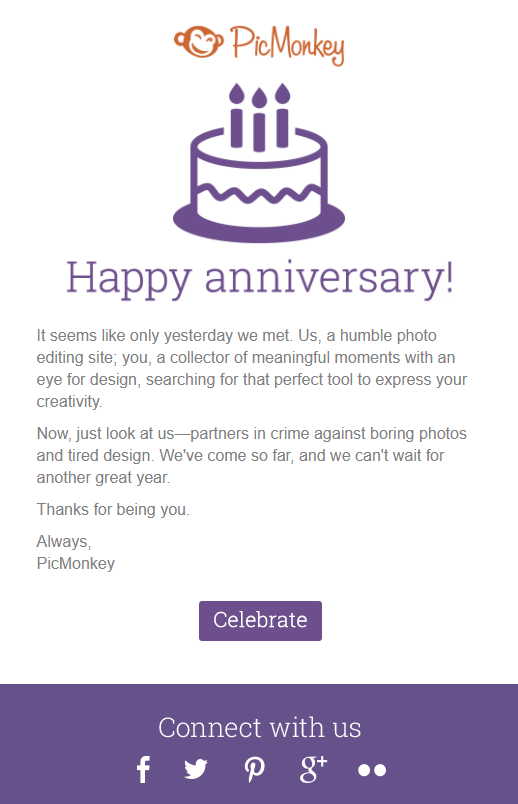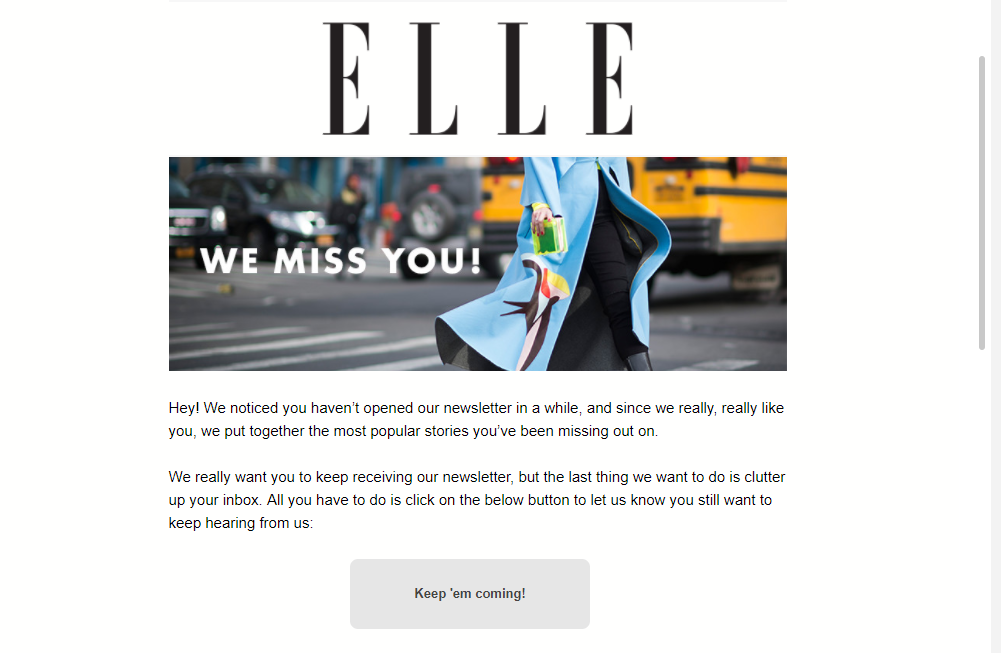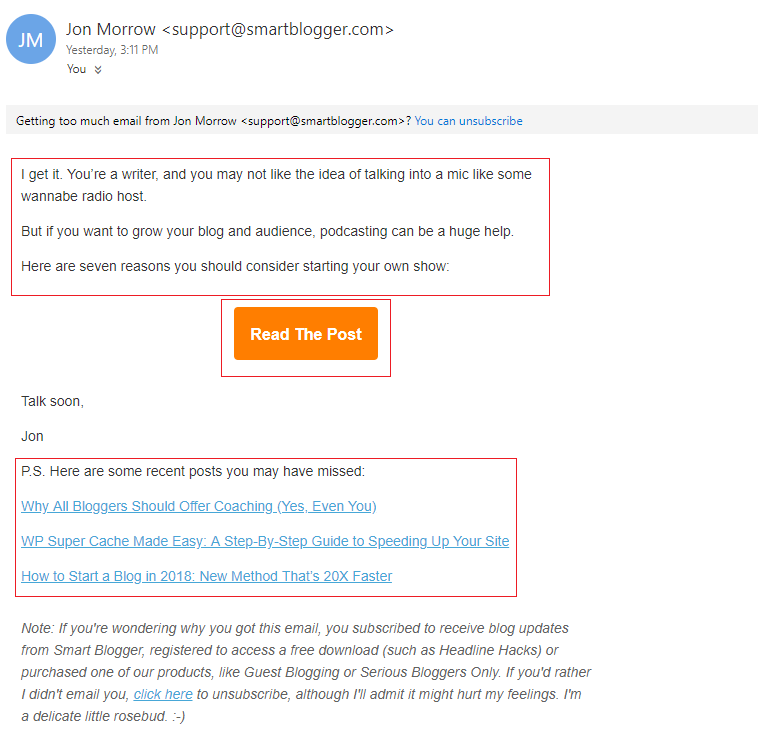9 questions to ask yourself if your email subscribers are unengaged
So, your email list is finally taking off and you’re getting new subscribers by the day. That’s great! But the quality of your subscribers is far more important than the number of them. Keeping your subscribers engaged so they remain on your list and look forward to your emails is ultimately what will continue to drive traffic back to your website and allow you to build a connection so you can sell to them effectively.
Stay fresh in the minds of your subscribers and get them engaging with your emails by asking yourself these handy questions.
How do you know if your subscribers are engaged?
First thing’s first – how do you know if your subscribers are engaging with your content? Your email provider should include a report of every email campaign you run, which can be very helpful for determining how engaged your list is.
Here are some metrics you’ll find in the report that you should be watching closely.

Open rate – This tells you how many of your subscribers are opening your message. The higher the number is, the higher the chances that your subscribers are interested in the content you’re sending to them.
Click rate – This shows you the number of subscribers that are clicking links and call-to-actions in your emails. A high click rate shows that your subscribers are actually reading your emails and are engaged enough to click through and continue interacting with your content.
Conversion rate – This is the number of subscribers that clicked your link and completed an action you wanted them to perform, like buying a product.
Another good indicator of engagement is your forward rate – if people on your list are sharing your emails with others, then that’s a good sign that you’re providing them with content they find valuable.
Your unsubscribe rate is another one to keep an eye on – if this is higher than normal after a particular email campaign, you might want to take another look at that email and identify what could have gone wrong.
These numbers will fluctuate with every email you send to your list, but if you notice an email has particularly higher click and open rates than normal, it would be a good idea to note what you’ve done there and continue that method in future emails.
Now you know how to get a grasp of your engagement rate, let’s look into keeping it high!
Are you utilising your welcome email?
Your welcome email is the first impression your new subscribers get of the mailing list they’ve just signed up for and is where their engagement will be at its highest – so make this email count!
Check out the open and click-through rates for my blog’s welcome email:

Compared with a normal email campaign:

So that goes to show that your welcome email really is your best chance to strike while the iron’s hot.
A good welcome email:
- Tells subscribers what they can expect from being a part of your list (what kind of content will you send them? How frequently will you email them?)
- Includes a link to any freebies (lead magnets) you’ve offered as an incentive for signing up
- Includes a good call-to-action
- Links to your social media pages
Additional ideas for your welcome email
As a blogger or small business, you may want to include a small background story to help your subscribers connect with you.
You might also want to include some links to the best content or most popular posts on your website or blog.
The key is to use your welcome email to remind your subscribers of why they’ve signed up in the first place, provide value from the offset and keep them exactly where you want – on your website!
Do you know what your subscribers want?
If your email metrics have been less than impressive recently, it might be worth sending out a quick survey to find out what your subscribers actually want to hear from you.
If your niche is quite broad, this is especially helpful for segmenting your email list and sending targeted campaigns (we’ll explore this later in the article).
It’s really easy to create a survey or quiz to send to your email list – you could try a free service like SurveyMonkey and embed the link in your email – then track and analyse responses and tailor your content appropriately. Another free option is SurveyAnyPlace, which allows you to build fun and interactive quizzes and surveys you can send to your subscribers in minutes.
Are you segmenting your email list?
Have you ever received an email that just didn’t seem like it was meant for your inbox? If you have, chances are you didn’t interact with it. And it’s the same for your subscribers – if they no longer feel that your content is relevant to them, they’ll stop engaging.
That doesn’t necessarily mean that there’s anything wrong with what you’re sending them – it’s just that you can’t please everyone and different subscribers have different needs!
Rather than sending an email campaign to your whole list, you could try sending specific campaigns to different segments of your list. For example, if you’re running an offer in a certain location, you could send an email letting customers in that location know.
But there are a variety of other ways you could segment your subscribers too – by age, gender and more.
With segmentation, you can target the right part of your audience at the right time, and they will be more inclined to open your emails if they know what you’re sending them is going to be relevant.
Are you sending a variety of emails?
If you’re sending your subscribers the same kind of email week after week or month after month, they’re eventually going get bored and feel less inclined to open your email because they know what to expect.
It’s important to have some variety in your email marketing strategy to keep things exciting!
Understandably, it can be tricky to come up with a constant flow of content ideas when you’re a busy business owner or blogger. But here are a few ideas to try when you get stuck on what to send your email list.
Round-up of recent posts
This is a great way to drive traffic back to your website whilst giving your subscribers a chance to catch up on anything they may have missed.
Interesting articles or resources that you’ve come across
An important thing to remember is that you can’t constantly sell to your list. Your strategy should have a good balance of self-promotion and offering value – so it might be worth sending your subscribers the occasional round-up of other resources and articles that would be of interest to them. If they know that they’re getting value with your emails, they’ll open them every time.
Gifts and freebies

Who doesn’t like surprises? A good way to keep your mailing list coming back for more is to send them unexpected emails – like the one in the example above – or emails containing special content that you can create for your subscribers, like an infographic. These can easily be created in minutes with a range of useful, free tools online. Here’s a roundup of the best free tools to help you create stunning marketing visuals you can send to your subscribers.
Exclusive, subscriber only blog posts
Most people don’t trust just anyone with their email address – so you need to continually show your subscribers why they made the right decision to go from a casual website visitor to a member of your mailing list. Extra content that is exclusive to your mailing list is a good way to do this. If you can’t think of a blog post to write from scratch, you could dig up an old post that doesn’t drive so much traffic anymore and rewrite it for your newsletter.
If you run a non-profit business, we have 7 more types of emails you can send to your list here.
Are you optimising your emails for mobile?
It’s no secret that the amount of people using their mobile to read emails is on the rise. So, if your emails aren’t optimised to be viewed on mobile, a large number of your subscribers may have trouble interacting with them and eventually stop engaging with them completely.
Most email providers will provide you with responsive templates so you won’t need to worry for the most part, but here are a few things you can do to further improve the experience for your subscribers viewing on mobile.
Image sizes – Have you ever received an email on your mobile where the image included was too big to fit on the screen? It doesn’t look great – and it’s terrible for user experience. Always ensure that any images in your email are optimised to fit the screen of the device it’s being viewed on.
Another note on images – be sure to include relevant alt-text on any you do use in your email. If they don’t load on your user’s phone, at least they’ll be able to tell what the image is from the alt-text.
Buttons are your friend – For your CTAs, you may want to consider using buttons that your users can press on with ease rather than links, which can be a bit fiddly on a mobile device.
Use small paragraphs – If a user is checking your email on-the-go, chances are they don’t have much time for a long-winded read. Also bear in mind that your mobile users are using a much smaller screen, so smaller paragraphs are easier to digest and more likely to be read. Don’t forget to make sure the font you choose is readable on mobile as well.
Don’t neglect preview text – You only have a few seconds to catch the attention of your subscribers and entice them to open your email. On mobile clients, there isn’t a lot of room to do this so utilising the preview text is crucial to further describe what your email is about.
Are you using engaging subject lines?
Getting your subject line right is crucial for your engagement rates. If it doesn’t get an enticing message across in just a few characters, you run the risk of your subscribers scrolling right past. Here are some tips for creating engaging subject lines that your audience won’t be able to resist:
Avoid spam triggers
If you’ve seen a huge drop in engagement, this could indicate that your subscribers aren’t even seeing your emails because they’re being sent straight to their spam folders. There are best practices to avoid this, like avoiding excessive capitalisation and symbols (*~!!) in your subject lines. There are also certain words that can see your email classed as spam if used too often. Here’s a huge list of spam trigger words to avoid for every topic.
Personalisation

Adding your subscriber’s name to both the body of your email and your subject line can help you to build rapport with your subscribers. When a subscriber sees their name, they may be more inclined to open the email as it indicates the content inside is especially for them.
Get creative
When you find a subject line that works, the return on engagement rates can be great. But unfortunately, using the same subject line format over and over again won’t continue to yield you the same results – your subscribers will know what to expect and get bored. Here are some ways you can get creative with your subject lines and keep your audience guessing:
Ask a question

Asking a question that inspires your audience to think is a pretty great way to boost your engagement. I immediately opened the email in the example above as I was curious to see where she was going with such a bold question. Interestingly, this was the subject line for her welcome email which is a very clever way of hooking her subscribers in from that very first interaction.
Spark curiosity

Being too cryptic can be risky – if it doesn’t pay off you’ll leave your subscribers confused and even weary of your future emails. But a little bit of mystery in your subject lines can work wonders if done correctly. I couldn’t resist opening this email as I was very curious and also a little worried that the blogger who sent it meant they were closing down their blog. Thankfully, they weren’t!
Include a call to action/action based statement
![]()
Tell the subscriber exactly what’s in it for them if they open your email. A clear and straightforward subject line with no bells and whistles can be refreshing and sometimes even more effective as your audience can be sure they’ll be interested in the content before they click ‘open’.
Put the most important words at the beginning
![]()
With most email clients, only a few words in the subject line will displayed so use them wisely. If you put the important words, like ‘Offer reminder’, ‘sale now on’ or ‘new post’ at the beginning, you can catch their attention with what you want them to know.
Are you deleting unengaged subscribers?
As your list grows, you’ll find that there will always be subscribers that aren’t engaging at all.
Don’t take it personally – this could be for many reasons, some of which have nothing to do with your content. For example, if one of your subscribers changes their email address, there’s not much you can do about that.
Keeping inactive subscribers on your list can decrease your open and click rates which can eventually prevent your more interested subscribers from receiving your emails.
Also, some email providers charge you for the number of subscribers you have, so it’s worth having an email list clean up every so often if it’s clear that there are people who just aren’t interested.
But before you do that, why not try to win those people back with a re-engagement campaign?

Send a straightforward email, asking the inactive subscriber if they would still like to receive your emails with a clear call to action they can click to indicate they’re still interested.
If that fails, here’s our guide to deleting unengaged subscribers.
Are your emails concise and to the point with a clear call-to-action?
Or even: what action do you want the subscriber to take after reading your email?
Here’s an example of an email I recently engaged with:

It’s very clear from this email that the sender wants his readers to read his latest post. It’s a straightforward email with one clear call-to-action.
The use of a PS section linking back to other popular posts is also another clever way of directing people who aren’t so interested in the subject matter of his latest post back to his blog anyway.
The next step you want your audience to take after reading your email should be clear in every email you send.
Wrapping up
We’ve covered a lot of ground here, but the important thing to remember is that your subscribers have signed up to your mailing list because they like your business or blog and want to hear more of what you have to say. This means you should create your email campaigns with confidence.
If you notice a drop in engagement, remember that chances are it’s less to do with your content and more to do with the issues addressed above, which can be turned around quickly and easily with a bit of extra effort.
If you still need more help, then checkout our free online course on engaging with your current customers, which features a section on email marketing.
